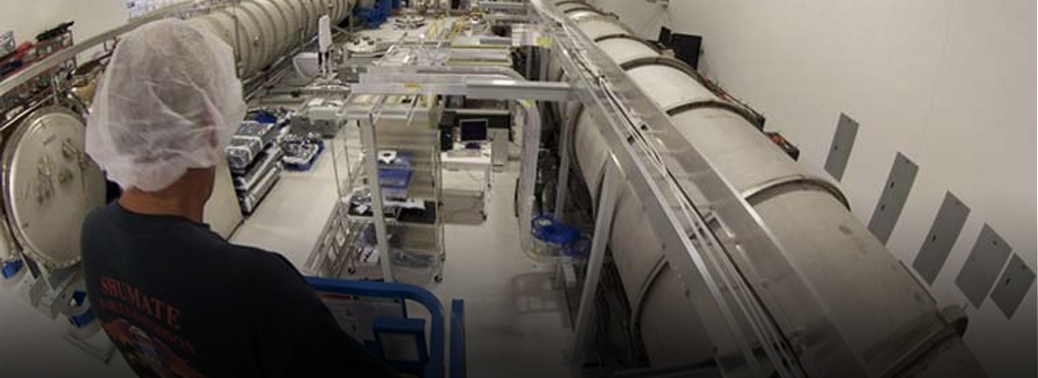LIGO-India
27, Aug 2018

Prelims level : Science & Tech
Mains level : Paper - III Science & Tech
- The Environment Ministry has allowed scientists to test the suitability of land in Maharashtra’s Hingoli district to host the India wing of the ambitious Laser Interferometer Gravitational Wave Observatory (LIGO) project.
About:
- The first of its kind in Asia to study gravitational wave.
- The LIGO-India project is an international collaboration between the LIGO Laboratory and three lead institutions in the LIGO-India consortium: Institute of Plasma Research, Gandhinagar; IUCAA, Pune; and Raja Ramanna Centre for Advanced Technology, Indore.
- The proposed LIGO-India project aims to move one Advanced LIGO detector from Hanford to India.
- The LIGO-India consortium, made up of physicists from several institutes, had submitted a proposal to “prospect” 121 hectares of forest land in Dudhala village, Hingoli.
- The project, piloted by the Department of Atomic Energy (DAE) and Department of Science and Technology (DST), is expected to be ready by 2025.
Project:
- An astronomical observatory, the LIGO detector will increase the ability and accuracy of localizing gravitational wave sources in the sky.
- The project involves constructing a network of L-shaped arms, each four kilometres long, which can detect even the faintest ripples from cosmic explosions millions of light years away.
- The construction of such a large, sensitive device — there are only three of its kind in the world — requires an extremely flat surface.
Background:
- Gravitational waves were predicted by Albert Einstein a century ago as part of his theory of general relativity, but the first hard evidence of their existence came only in 2015, when two U.S. detectors found the first such signal.
- Gravitational waves are ripples in the otherwise tough, stiff fabric of spacetime produced by the most violent phenomena the cosmos can offer—things like exploding stars and collisions between ultra-dense neutron stars or merging black holes.
- These ripples would travel at the speed of light through the Universe, carrying with them information about their cataclysmic origins, as well as invaluable clues to the nature of gravity itself.
- The strongest sources of gravitational waves are among the enigmatic objects in our universe: black holes, neutron stars, supernovae, even the Big Bang.
- The LIGO facility consists of two identical L-shaped detectors in Washington state and Louisiana, each of which employs lasers and mirrors to measure the tiny changes in spacetime made by passing gravitational radiation.
- Known as interferometers, these high-tech underground stations do not rely on light in the sky like a telescope does, but instead sense vibrations in space and can pick up the “chirp” created by a gravitational wave.
- Extracting the information carried by the waves to address questions in both physics and astronomy depends on our ability to identify where the individual sources are on the sky. This requires a network of detectors spread widely over the Earth.
- LIGO operates two sites in the United States and collaborates with a similar detector in Italy (Virgo). Together they can triangulate sources over part of the sky. LIGO-India will enable scientists to locate sources over the entire sky.
- The discovery of gravitational waves earned three U.S. scientists the Nobel for physics in 2017.
Need of it:
- Gravitational waves are so hard to detect. By the time gravitational waves reach us from the distant events that spawn them, they distort spacetime by an utterly minuscule amount. The distortion is many times smaller than the width of a proton, one of the particles in an atom’s nucleus. Measuring such minute changes in length is pretty much impossible for most instruments.
Significance:
- Previously, scientists have relied primarily on observations with electromagnetic radiation (visible light, x-rays, radio waves, microwaves, etc.) to learn about and understand objects and phenomena in the Universe.
- But it is completely different phenomenon, it carry information about cosmic objects and events that is not carried by usual electromagnetic radiation .
- Detecting and analysing the information carried by gravitational waves will allow us to observe the Universe in a way never before possible.
- It will open up a new window of study on the Universe, give us a deeper understanding of these cataclysmic events, and usher in cutting-edge research in physics, astronomy, and astrophysics.
- More importantly, since gravitational waves interact very weakly with matter (unlike electromagnetic radiation), they travel through the Universe virtually unimpeded giving us a clear view of the gravitational-wave Universe.
- Measuring the gravitational-wave background will allow us to study populations of black holes at vast distances.
- Hosting such a detector in India will improve the odds of detecting more such phenomena. The first detection of gravitational waves will be one of the highest profile scientific discoveries of our time. Engaging the Indian scientific community in this quest will raise the visibility and appeal of experimental science in India.
- The presence of a world-leading facility in India can be used to attract students and inspire them to pursue technical careers.
- The physical measurements required for gravitational wave detection are arguably the most precise ever made, and they involve cutting edge technologies that have many non-military applications.
- The LIGO Laboratory will provide the hardware for a complete LIGO interferometer, technical data on its design, installation and commissioning, training and assistance with installation and commissioning, and the requirements and designs for the necessary infrastructure
- The LIGO project operates three gravitational-wave (GW) detectors. Two are at Hanford in the State of Washington, north-western USA, and one is at Livingston in Louisiana, south-eastern USA.
- However, there are more than 100,000 gravitational wave events every year too faint for LIGO and Virgo to unambiguously detect due to less coverage. Thus by establishing LIGO in India makes it possible to detect it.






